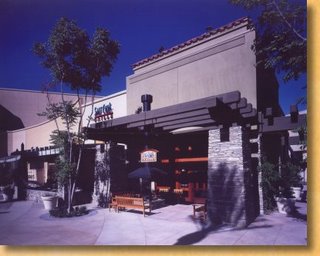
The Chambers Hotel opened recently at 9th and Hennepin in downtown
Arriving at the Chambers is an experience. You can come into the lobby bar from an entrance on
We had a few minutes before our reservation, so we asked to see the art gallery. It’s not large. But it’s nice to see a commitment to original art. The pieces on display the night my wife and I were there were quite modern. We were told that after the initial display, it would be replaced with exhibits of all local artists. Presumably there are original pieces of art in the guest rooms as well.
In my Sept. 11 post on Michelangelo’s in
The other thing about the dining room itself is its industrial décor. While the hotel lobby and bar are sleek, white, and open, the dining room downstairs features an open ceiling, exposed ductwork, iron beams, and the space is broken up by support pillars. The stairway down from the lobby also chops up the space by leading right into the middle of the dining area, almost creating four separate spaces.
We were seated at a table under the stairway. At first we were a little hesitant and considered asking for a better table. But it turned out to be a great table because we could see everyone coming and going. After all, this is a “see and be seen” venue.
We had been warned that the Chambers attracts a young crowd, and that we would feel old. Neither of us found that to be the case. We thought that the people in the lobby bar and the dining room were a nice mix. (The rooftop (5th floor) lounge was definitely more upscale, youth oriented.) Open Table says that the dress code is “casual dress.” The night we were there, people were more dressed up and very fashionable. We only saw one table of people wearing jeans. I had a sport coat and tie, and I wasn’t the only one.
No matter how you feel about the décor of the hotel or the dining room, the real star is the food. In a word, it’s fantastic.
My wife started with a mushroom soup. The server brought a bowl with grated parmesan cheese on one side and charred poblano peppers on the other. Then he poured the soup over the peppers and cheese. The flavors were amazing with pieces of charred peppers mixed with parmesan and the creamy mushroom soup.
My first course was like a Caprese salad made with grilled figs instead of tomatoes. The mozzarella was ‘house-made.’ It was very creamy and yielded nicely to the bite. The salad was served with ice wine vinaigrette, which was very good as well.
For an entrée, my wife chose striped bass crusted in spices and served in a sweet and sour broth. The fish was cooked through, as my wife likes it. The spices formed a crust over the top of the fish. It was a little spicy for her tongue, but tolerable. (She confesses to being a wimp when it comes to spicy food.)
I chose duck a l’orange. A duck breast was served seared and sliced on an orange sauce. I didn’t think the orange sauce was very distinctive. What really made the dish for me was a small mound of shredded Asian pear and crystallized ginger. It complemented the duck perfectly.
For wine, we chose a Moulin-a-Vent, Chateau des Jacques beaujolais. We both liked it very much. It was not too heavy to drink with the fish, especially considering the spice crust.
When we picked Chambers Kitchen, we wanted a special place to celebrate my birthday, and we didn’t care if it was an expensive dinner. That said, we were pleasantly surprised that the evening was not expensive. If we would have had dessert, I suppose the total would have been more. But we left feeling very satisfied.
A final word about service: when we were seated, our server seemed to think we were in a hurry. We were taking our time talking about what we might like to order and selecting a wine. He kept stopping by our table to see if we were ready to order, not in an impatient way, but just checking. When he finally figured out that we wanted to relax and enjoy the evening at a slower pace, he accommodated very nicely. After our first courses were served, we asked him to wait a while before bringing the entrées. He honored the request, and he checked with us to see when we wanted the next courses brought out. He also was very accommodating about taking our photo.
We do have some nice restaurants in Minneapolis-St. Paul, special places to celebrate a birthday. Chambers Kitchen certainly earned a place on our list for future visits.








